Are you planning to decorate your house with indoor plants? Well, who doesn’t want to lighten the green lamp in their house? Here we are picking the 30 most beautiful indoor plants in India that will outshine the other aspects of your home.
1) Chinese Money Plant
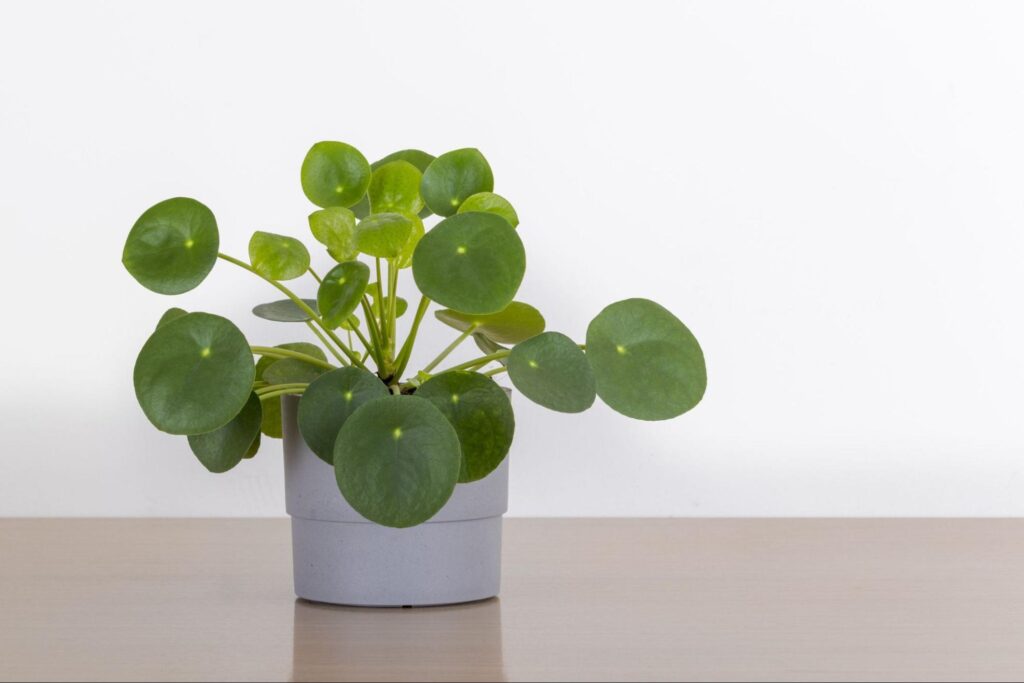
- Scientific Name Pilea peperomioides
- Common Name Coin plant, pancake plant
- Sun Exposure Bright indirect light
- Watering schedule Moderate
- Native Area China
The Chinese Money Plant is one of India’s most beautiful indoor plants. It is an eye-catching green beauty that has become one of the most popular plants in the world. This plant belongs to the stinging nettle family (but it won’t sting you!) and is extremely easy to care for. The flat, spherical leaves distinguish the Chinese money plant. They even got the name pancake due to their long, thin, scarlet stems, leathery, thick, dark green shape. These are stunning beautiful indoor plants in India.
People believe this Chinese money plant brings owners good luck, money, and prosperity. It is where the concept of money originates. The huge, round leaves mirror coins because they pile on one another. So this little Chinese money plant may do more than look great; it may also bring you good luck! Isn’t that fantastic?
Mature Chinese money plants do occasionally bloom with very small buds on stems that arise from the bottom of the plant. They are not very pretty, so you can simply trim them out to ensure the plant’s energy goes toward leaf growth. If you want to experiment by propagating through seeds then only you should consider growing flowers.
2) Jade Plant
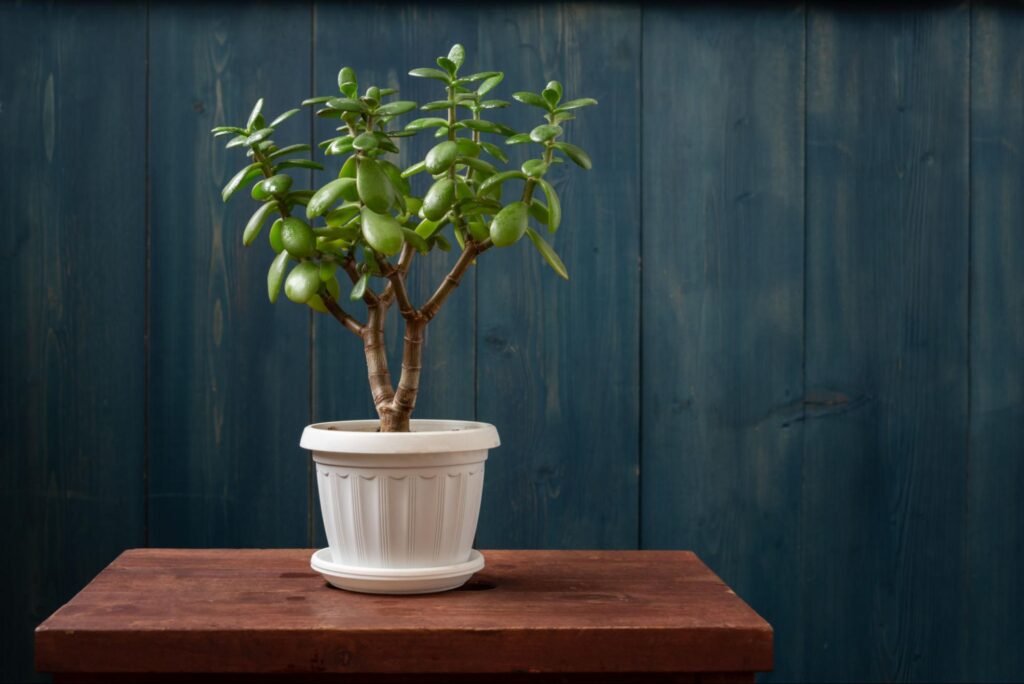
- Botanical Name Crassula ovata
- Common Name Jade plant
- Family Crassulaceae
- Sun Exposure Full sun
- Native Area South Africa
Who doesn’t know Jade plants? They are the most beautiful indoor plants in India. They have a small tree-like look with strong, woody stems and oval-shaped leaves, making them ideal for use as decorative houseplants. When cultivated indoors, jade plants can reach three feet or more heights.
Warm, dry conditions available in most homes are most suitable for jade plants. During the growing season (spring and summer), keep the plant well-watered; during the dormant season, keep it drier (fall, winter).
Room temperature of 18° to 24°C is ideal for jade plants. Still, they prefer slightly cooler temperatures at night, 13°C, and in winter. During the winter, keep jade plants away from draughty areas and cold windows.
One primary jade plant benefit is the plant’s longevity. With appropriate maintenance, jade plants can live between 50 to 70 years—occasionally even more than that. Because of this, they’re usually handed down generationally.
Plant maintenance for jade is relatively easy, and it won’t be a burden on you that much. Many individuals have jade plants in their homes and offices, and are known to bring good luck. Pet owners should take special caution while placing a jade plant in their homes. These beautiful plants are toxic to cats and dogs.
3) Donkey’s Tail Plant

- Botanical name Sedum morganianum
- Common name Burro’s tail, lamb’s tail
- Sun exposure Full
- Native area North America
Donkey’s tails are the most beautiful indoor plants in India. They are a very popular and easy-to-grow succulent that features rows of soft, tear-drop-shaped leaves. The leaves appear interlaced or plaited into the stout stems, green to gray-green or even blue-green, with a slightly powdery appearance.
It is a drought- and heat-tolerant plant that thrives in warm to temperate climates. It produces a burro’s long tail, sweeping stems with thick, meaty, green leaves. You can plant it in a full sun garden bed or on the patio. TDonkey’s tail stunning beautiful indoor plants India grows best indoors in a well-drained container with plenty of light.
Donkey’s tail, also known as burro’s tail or lamb’s tail, can be grown and propagated all year indoors, but it is best planted outside in the early spring. Late summer brings red, yellow, or white flowers, though the plant rarely blooms indoors.
Its eye-catching tipped leaves surrounding draping limbs are quite delicate and can break off with even the slightest contact. For that cause, it’s most useful to pick a bright spot to place or hang your donkey’s tail plant and then let it be.
4) Snake Plant

- Common Name Snake plant, viper’s bowstring hemp, St. George’s sword
- Botanical Name Dracaena trifasciata (formerly Sansevieria trifasciata)
- Family Asparagaceae
- Sun Exposure Shade to partial sun
- Native Area West Africa
Are you looking for a low-maintenance plant? A snake plant is an excellent choice. This hardy snake plant is still popular today because of its adaptability to a wide range of growing situations. Most snake plant variants feature stiff, upright, sword-like leaves with grey, silver, or gold bands or edges. The architectural aspect of the snake plant makes it an ideal choice for modern and contemporary interior designs. It’s one of the most beautiful indoor plants in India.
The snake plant can grow from six to eight feet tall and has rigid, sword-like leaves. These stunning beautiful indoor plants in India come in a variety of colors. Still, most have green-banded leaves with a yellow border. These plants are simple to grow and practically indestructible in many circumstances.
This plant is cultivated widely mainly because it comes with numerous benefits- filtering indoor air, removing toxic pollutants, helping boost mental health, being effective against allergies, enhancing the “energy” of a space, and helping with minor ailments.
They prefer very bright light or practically dark parts of the house to flourish. It looks excellent in a container and prospers on the floor or in tabletop arrangements. Unfortunately, it is toxic for dogs and cats.
5) Silver Dollar Plant
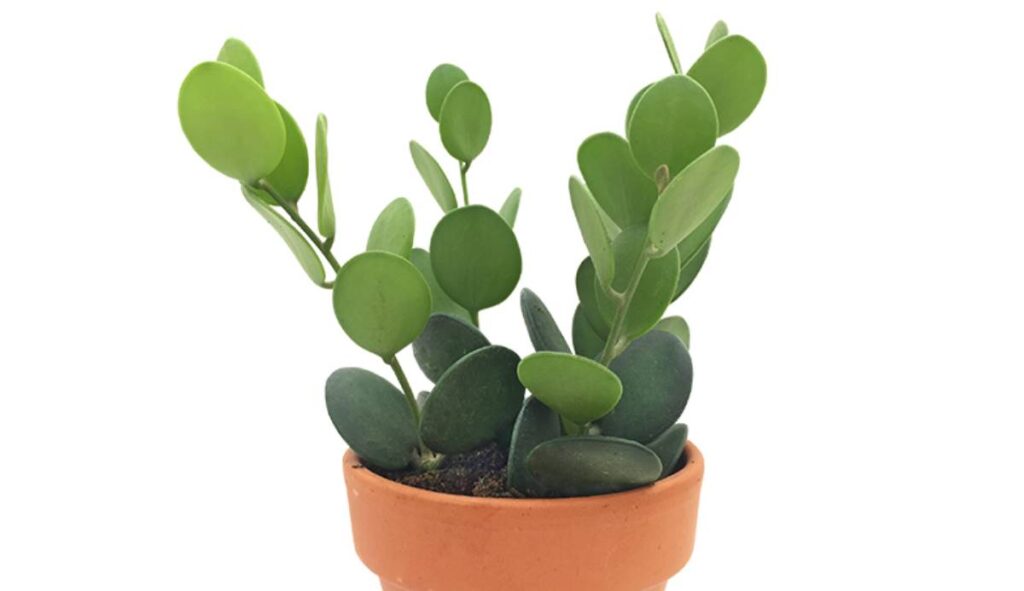
- Botanical Name Lunaria annua
- Common Name Lunaria, money plant, honesty, moonwort
- Plant Type Herbaceous perennial
- Sun Exposure Full sun, partial shade
- Native Area Europe, Asia
These iridescent “leaves,” sometimes known as Lunaria or silver dollar plants, actually seed pods from the plant Lunaria annua. They bloom in the early to midsummer and have beautiful four-petaled pink to purple blooms that grow in racemes or clusters atop the long stalks. If you are the one who tends to forget to water your plants, the Silver dollar plant is the right pick for you.
These delicate blossoms generate seed pods, making caring for a money plant worthwhile. Because this is succulent, ensure it’s in a container with plenty of drainages. Because this is a climbing succulent, give it plenty of areas to flourish, and it will provide you with a happy environment.
A possible disadvantage in cultivating silver dollar plants is the ease with which they spread. Get in touch with your county extension office before growing any to determine whether they are recorded as intrusive plants in your area.
6) Oxalis

- Common Name Wood Sorrels, False Shamrocks
- Sun Exposure Full sun
- Watering schedule Low-Moderate
- Native Area South America and South Africa
These purple beauties are the most beautiful indoor plants in India. The Oxalis appears to dance in reaction to high light and low light at night, with leaves that open and close during the day.
Oxalis triangularis appears like a collection of small purple butterflies folded neatly at night before opening wide to the early sunlight. Even “non-gardeners” fall in love with this delightful beauty because of the vibrant purple color of its leaves. Containers with silver or chartreuse are particularly effective in highlighting their distinctive coloration.
Plant your bulbs in a container indoors and crowd them together, placing them just an inch apart for a perfect look.
Oxalis is harmful to pets and humans upon consumption. In very considerable quantities, oxalic acid may be viewed as slightly toxic, meddling with proper digestion and kidney function. The best approach is always to keep this plant out of reach of small kids and pets.
7) String of pearls
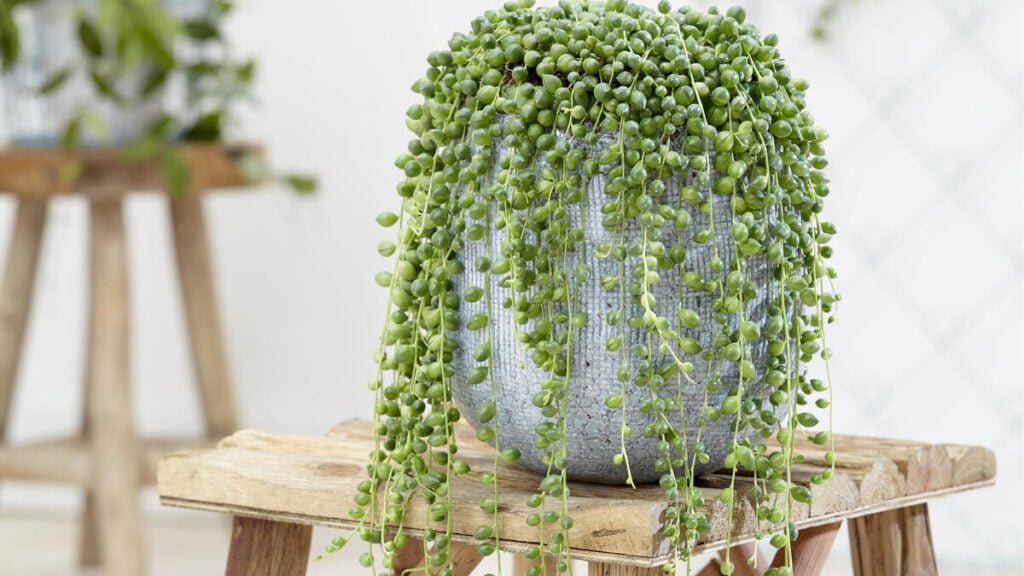
- Common Name String of pearls, a string of beads, a string of peas, rosary vine
- Botanical Name Curio rowleyanus (formerly Senecio rowleyanus)
- Family Asteraceae
- Sun Exposure Full, partial
- Native Area Africa
A string of pearl plants is distinctive vining succulents with tiny pea-shaped leaves instantly identifiable. With its fleshy green, pea-like leaves sprawl over the sides of containers or hanging baskets, the string of beads plant resembles a beaded necklace.
You can place these stunning beautiful indoor plants in India in a location that receives at least 6 to 8 hours of bright, indirect sunshine every day. This drought-tolerant succulent can last for long periods without water.
If you want to preserve its size and attractiveness, you may need to prune your strings of pearls.
You can plant string of pearls at any time of year, although they will thrive in the summer. It produces white flowers with a sweet cinnamon-like aroma in the spring and its unusual sphere-like leaves; nevertheless, it rarely flowers inside.
Although the String of Pearls is a lovely plant to look at, its sap is deadly to both people and animals. Consider planting a string of pearls with numerous stems in a hanging basket to help this plant sparkle. You can interlace branches of strings of pearls, and it can be grown in a dish to create a terrestrial mat as it does in the wild.
8) Lady Palm Plant
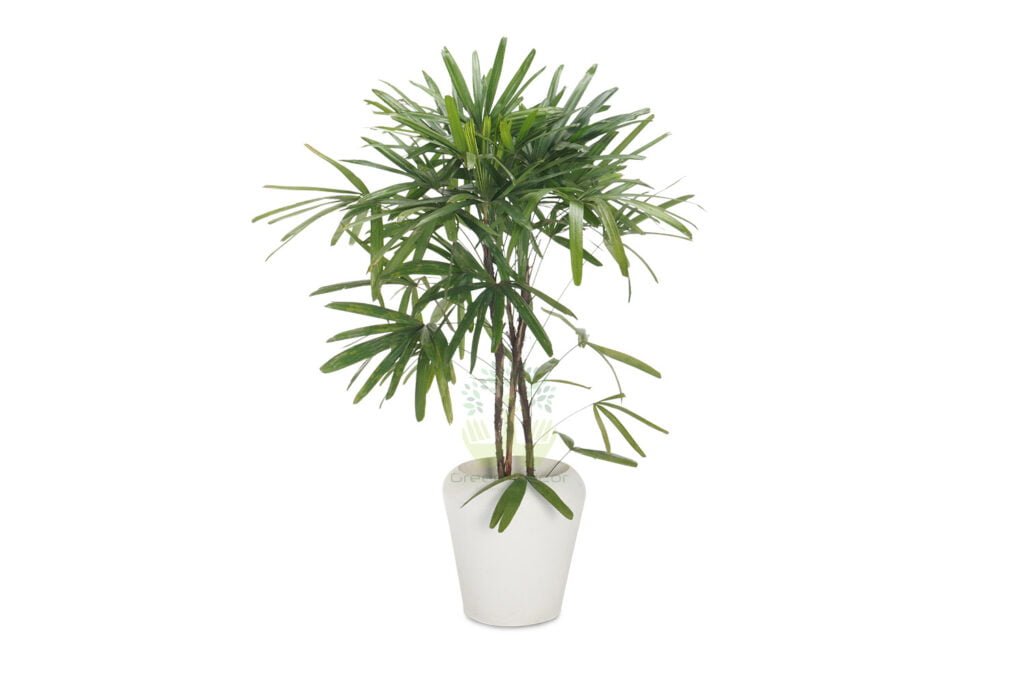
- Scientific Name Rhapis excelsa
- Common Names Bamboo palm, miniature fan palm
- Sun Exposure Partial, shade
- Native Area China
Lady palm plants (Rhapis excelsa) offer an oriental look with broad, dark green, fan-shaped foliage on long stalks. They have a formal elegance as stand-alone plants, and when planted in masses, they add a touch of the tropics to the landscape.
Lady palm plants’ fan-shaped, glossy green fronds with between five and eight narrow grow on the stems. This palm is one of India’s most beautiful indoor plants since it is exceptionally tolerant of low light conditions. Though you can grow them all year-round, it’s ideal for planting them in the spring at the start of the growing season. This palm grows at a snail’s pace, gaining less than a foot in height each year, and gardeners love this aspect. You don’t have to prune it often.
Lady palm plants demand bright and indirect light. Small varieties, often known as miniature types, are ideal for large spaces such as living rooms and family rooms. Large varieties can liven up a room’s corner. A sheer curtain covering south or west-facing window is a fantastic choice for these beauties.
9) Peperomia
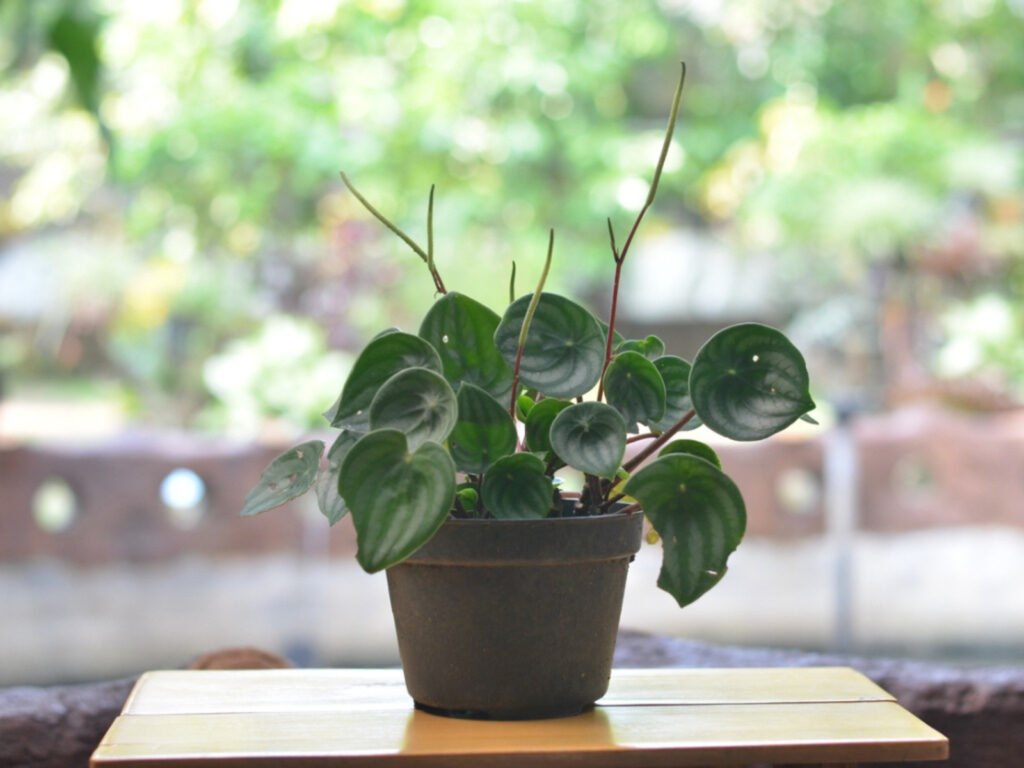
- Scientific name Peperomia obtusifolia
- Sun exposure Part Sun, Shade Sun
- Watering Schedule Low-Moderate
- Native area southern Florida and South & Central America
Peperomias are one of the most simple houseplants to grow. Peperomias require places with 40 to 50% humidity, such as terrariums, because they are native to tropical cloud forests, where humidity is typically over 90%.
Peperomias, the most beautiful indoor plants in India, are also easy to grow in your bathroom due to the high humidity levels.
Make sure to plant peperomias in well-drained soils when growing them in pots. Peperomias are best cultivated in small containers because they have a limited root system.
They are grown for their leaves and come in various colors. They have thick, meaty leaves that hold water in general. The leaves can be as small as a dime and as huge as a baseball, depending on the species of the plant. Peperomia leaves are usually rich emerald green, but many species have beautiful silver markings and patterns.
10) Pothos
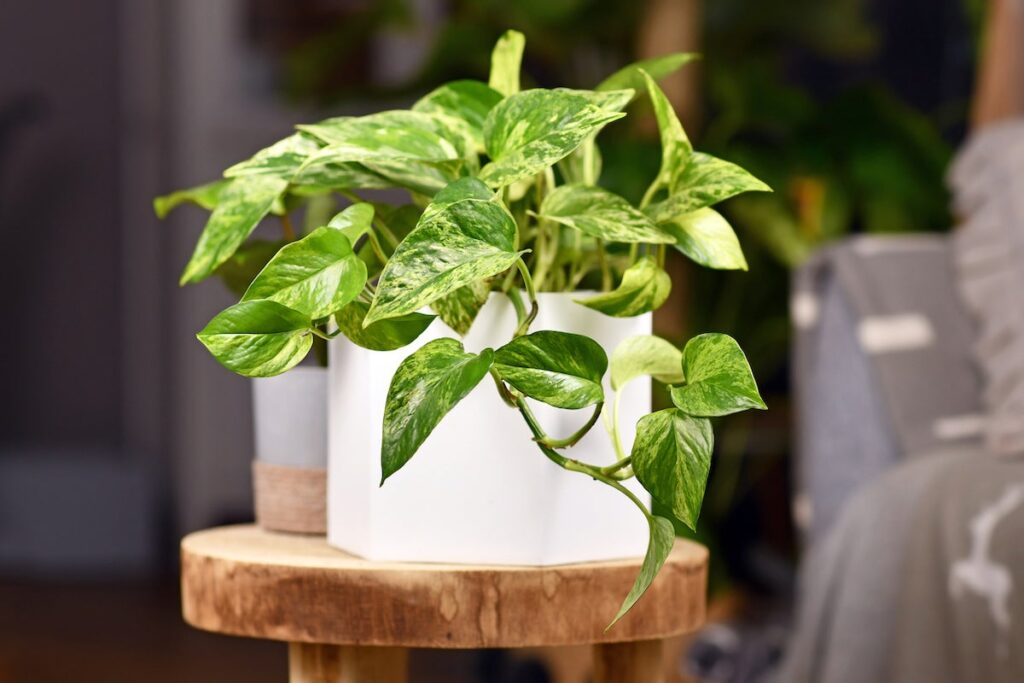
- Common Name Golden pothos, devil’s vine, devil’s ivy
- Botanical Name Epipremnum aureum
- Family Araceae
- Sun Exposure Full sun, partial shade
- Native Areas South Pacific
Even if you neglect to water your plants regularly, pothos is one of the easiest houseplants to thrive. This trailing vine’s pointy, heart-shaped green leaves are occasionally variegated with white, yellow, or pale green striations. Pothos can be grown all year indoors and grows swiftly, adding 12 to 18 inches of length in a month. This plant is hazardous to pets, so keep that in mind.
Pothos is the most beautiful indoor plant in India, and their care is relatively simple. It can endure low light and is an excellent addition to your bathroom or office. Pothos plants thrive in a variety of conditions. Pothos plants thrive in bright, indirect, and dim light and can be cultivated in dry soil or water vases. Pothos do almost as well in nutrient-poor soil as in nutrient-rich soil.
11) Asparagus Fern
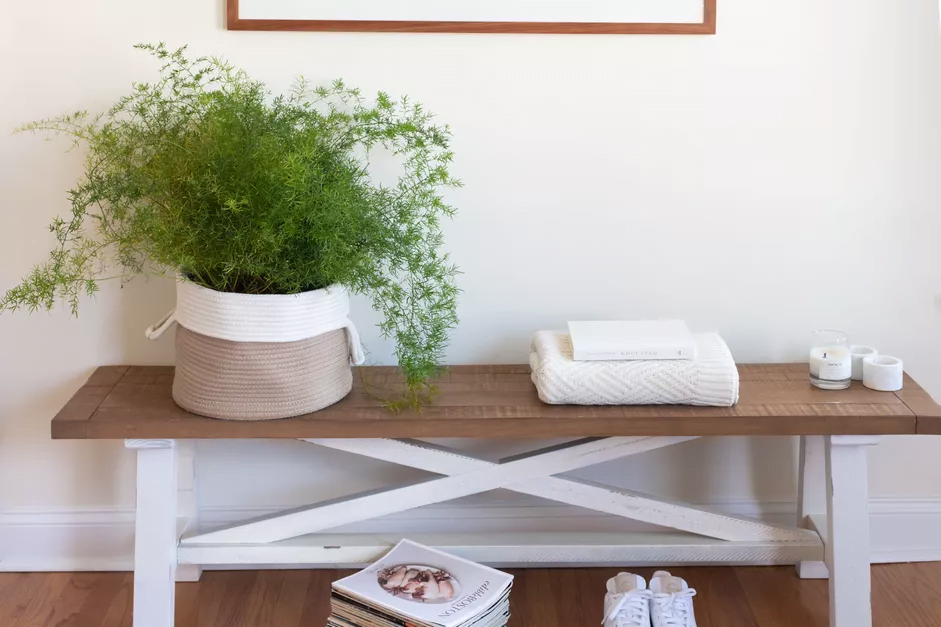
- Common Name Asparagus fern
- Botanical Name Asparagus aethiopicus, A. densiflorus
- Family Asparagaceae
- Sun Exposure Bright, indirect light (indoors)
- Native Area South Africa
The asparagus fern plant is typically found in a hanging basket. It can be used to decorate the deck or patio in the summer and help clean the air in the winter. The plant is a Liliaceae family member, not a true fern. All cherish these stunning beautiful indoor plants in India.
Plants in mixed combinations benefit from the smooth texture of this plant’s little needle-like leaves. The delicate white blossoms of asparagus ferns are followed by scarlet berries that attract birds. Indoor places are generally dry during the winter due to the heat. Make sure to mist the asparagus plant daily and have a pebble tray nearby.
It’s simple to grow asparagus fern. Although the frilly, feathery asparagus fern plant appears soft and fuzzy, you may be startled to learn that asparagus ferns contain sharp spurs when managing them. It shouldn’t be the reason not to grow these beauties; merely wear gloves when caring for them.
Asparagus fern’s “leaves” look like leaf-like cladodes. The real leaves are hardly visible scales around the bottom of the cladodes. While the ferns look velvety and harmless to touch, they’re quite sharp. Put on gardening gloves if you intend to prune an aged plant. When asparagus fern is content in its spot, it can create tiny flowers followed by mildly poisonous berries.
12) Yucca Plant

- Common Name Yucca plant
- Botanical Name Yucca spp.
- Family Agavaceae
- Sun Exposure Bright, indirect light
- Native Area North America, the Caribbean
Indoors, a yucca plant can serve as a focal point or as part of an attractive indoor display. Although some potted yucca plants are modest, growing yucca in containers is a terrific way to bring the outside inside in a big way. Yucca plant colors vary from green to bluish, with cream, yellow, and white variegations according to the variety.
Yucca plants are the most beautiful indoor plants in India and are the talk of the town in many areas. Yucca plants are not difficult to grow under the appropriate conditions. They thrive on a little neglect rather than a lot of attention. A light nook with relatively low humidity is ideal for a yucca plant. Pet owners should use caution while bringing a yucca into their homes because all parts of the plant harm dogs and cats.
If you are planting yuccas outdoors in the ground, make sure they are away from pathways and sidewalks since their leaf tips are pointy and sharp and can harm passersby. Also, their roots can grow rapidly and disrupt sidewalks. A perfect place for this plant is in the sun but provides a few hours of shade during the day.
13) Air Plant
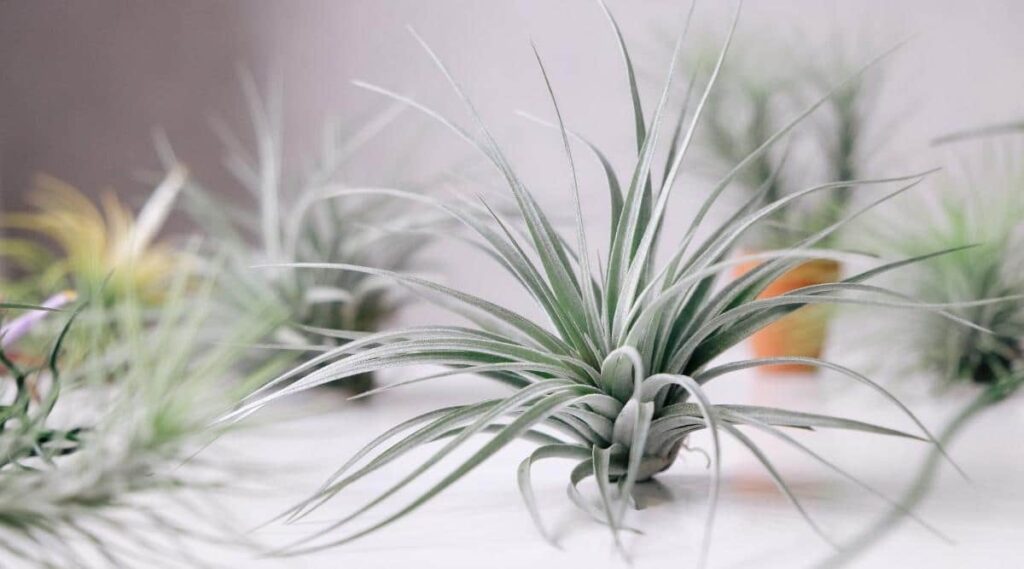
Are you looking to expand your indoor plant collection? Consider an air plant. Because they do not require soil to develop, air plants are known to be low-maintenance and entertaining around the house. Air plants appear almost extraterrestrial in their ability to grow entirely in the air. There’s no need for any dirt.
These most beautiful indoor plants in India have gained popularity in recent years. Furthermore, their leaves can resemble alien tentacles or the appendages of an exotic sea creature. Make sure to grow these tiny beauties!
Most air plants may be watered successfully using the soaking method, which involves soaking the plant in distilled water for 20 to 40 minutes every 1 to 2 weeks. On the other hand, some air plants prefer regular misting or a brief immersion over a lengthier soak. To avoid drying out, air plants thrive in warm, humid environments. Air plants can tolerate normal household temperatures as long as they are not exposed to cold draughts or temperatures in the winter.
These beauties can be displayed in a terrarium, suspended from the ceiling or a curtain rod, placed inside a specific air plant holder or planter, or mounted on another medium such as driftwood, rock, or wood board.
14) Spider Plant

- Common Names Spider ivy, ribbon plant
- Botanical Name Chlorophytum comosum
- Family Asparagaceae
- Sun Exposure Partial, shade
- Native Area Central and Southern Africa
Despite their unsettling moniker, spider plants (Chlorophytum comosum) are among the most beautiful indoor plants in India. They look lovely if you can accurately replicate their native tropical environment by giving warm temperatures and humid air. These warm-weather perennials can withstand less-than-ideal conditions when grown inside.
Rosettes of slender, softly arching leaves can grow 12 to 18 inches long on these plants. The leaves of spider plants might be green or green and white striped.
These stunning beautiful indoor plants in India produce tiny white blooms on long stems in the summer and miniature spider plants (offsets) known as “pups.” The plant’s name comes from the pup mirror tiny spiders.
These hardy plants can withstand much damage, making them ideal for newbie gardeners or people who lack a green thumb. Spider plants thrive if you give them well-drained soil and bright, indirect light.
NASA once highlighted that these plants are an ideal pick for their purported ability to filter the air. They are a timeless and lovely plant to have in your home.
15) Peace Lily
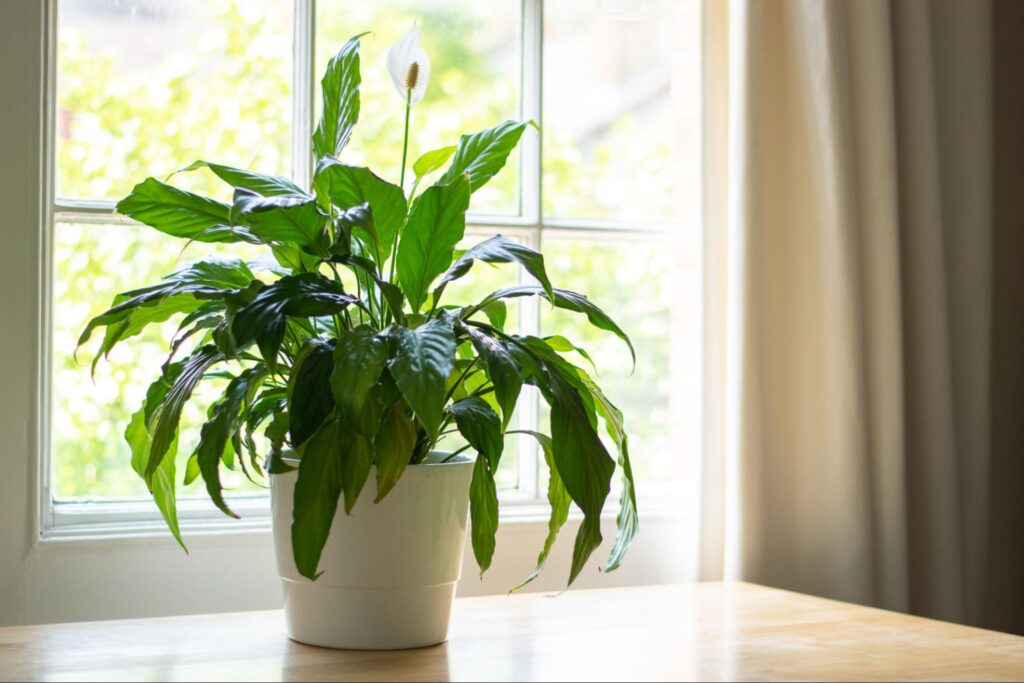
- Common Name Peace lily, Spath lily
- Botanical Name Spathiphyllum spp.
- Family Araceae
- Sun Exposure Partial shade
- Native Area Central America, Asia
What’s not to like about the peace lily, a simple-to-grow indoor plant that adds color and liveliness to low-light areas while also cleansing the air? Peace lilies are the most beautiful indoor plants in India, known for their ease of maintenance. The peace lily is tough, forgiving, and will even let you know when it’s thirsty by drooping.
Peace lilies are a wonderful indoor plant for the home or workplace. These beauties not only light up a room but also help purify the air in it. These plants usually have dark green leaves and white “flowers.” People believe the flower of peace lily is a specialized leaf bract that grows hooded over the blossoms.
As a houseplant, the peace lily is well-known for its air-purifying characteristics; it excels at breaking down and neutralizing harmful gases. The plant has shiny oval leaves that emerge from the soil with tips. A well-grown peace lily can bloom twice a year, providing blossoms for several months. Pets1 and humans are both poisoned by peace lily bushes.
Peace lilies are commonly grown as potted house plants all over the world. If you have potted peace lilies, you can carry them outside during the summer season. But once temperatures drop in the fall, bring them back inside. Tending for a peace lily indoors is fairly easy. Supply your plant with relatively moist soil and refined light, along with consistently temperate conditions.
16) English Ivy Plant
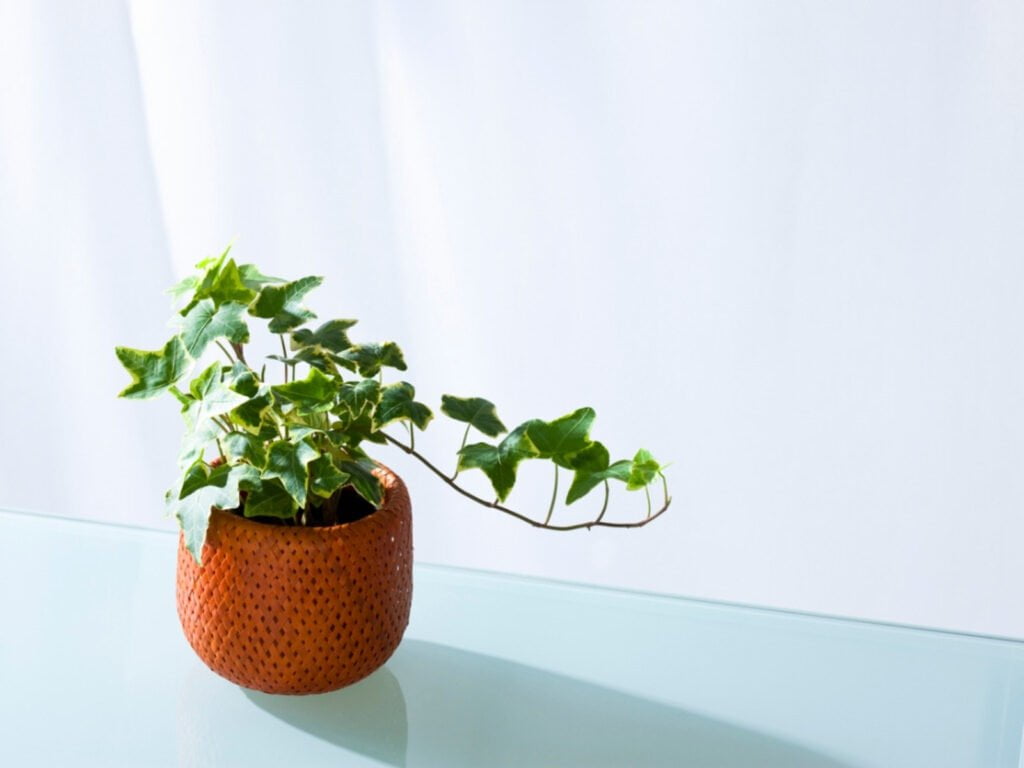
- Common Name Common ivy, European ivy
- Botanical Name Hedera helix
- Family Araliaceae
- Sun Exposure Part shade to full shade
- Native Area Europe, Scandinavia, Russia
Hedera helix (English ivy) are excellent climbers, attaching to practically any surface with the help of microscopic roots that sprout along the stems. Because English ivy is easy to maintain, you can plant it in remote and difficult-to-reach locations without anxiety.
Common ivy can be grown indoors in pots with a stake or other vertical framework for climbing or in hanging baskets where you can spill it over the edges. You may also topiary it by growing it in a pot with a curved wireframe. When planted this way, variegated varieties are extremely appealing.
English ivy care requires very little effort. These vines thrive in damp environments, but they can survive dry circumstances once established. Water them frequently enough to keep the soil moist until the plants are established and growing.set
Indoors, English ivy grows with reasonably cold evenings and frequent watering to keep humidity levels up. Despite being a regular item at garden stores, it is typically considered a picky houseplant.
17) Dragon Tree

- Common Names Dragon tree, dragon plant, Madagascar dragon tree
- Botanical Name Dracaena marginata
- Family Asparagaceae
- Sun Exposure Full sun, partial shade
- Native Areas Madagascar
Dracaena marginata is a species of the broad plant genus Dracaena, which has a wide range of leaf sizes, colors, and trunk forms. The marginata is one of India’s most beautiful indoor plants that grow into an appealing plant and makes a fantastic focal point of a room.
Compared to other Dracaenas with arching leaves, the leaves are rather narrow. There are three types: one with a dark red outer edge and a green center, another with a green center with red and yellowish stripes, and a third with broad red margins.
The dragon tree can be planted all year and produces tiny white flowers in the spring (though it rarely flowers indoors). It is more commonly grown as a potted houseplant with a height of 6 feet or less. Keep pets away from the dragon tree because it is poisonous to them if eaten.
Dragon trees are popular as large potted plants for homes and offices because of their good temperature tolerance. It would help if you regularly placed them in well-draining soil and water during the growing season. Dragon trees may flourish in various light settings, but indirect bright light is preferable.
18) Calathea Ornata
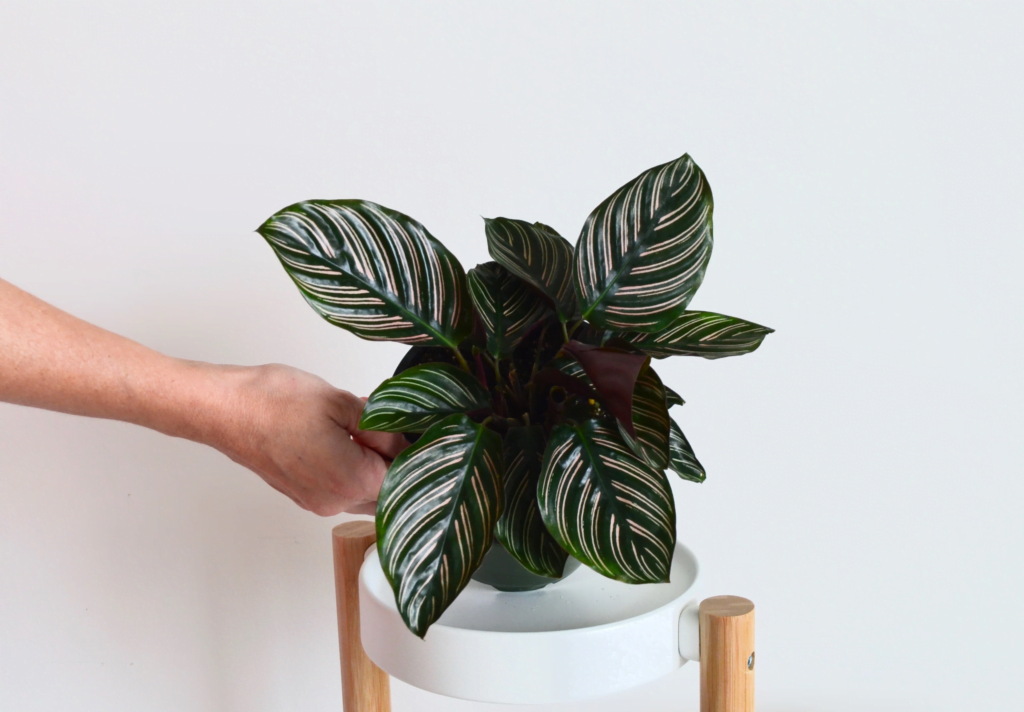
- Botanical name Calathea
- Common name Zebra plant, peacock plant
- Sun exposure Partial sunlight, full shade
- Native area South America
The Calathea plant, also known as the rattlesnake plant, is a perfect choice for office decoration. It is one of India’s most beautiful indoor plants for both households and businesses. It is a plant that enjoys indirect lighting, making it ideal for use in homes and offices. Calathea plants are popular for interior use since they are often easy to maintain and look wonderful, providing brilliant green plants to brighten up small rooms.
It is a genus of plants with strikingly defined, oblong leaves coming in a rainbow of hues. It is an appealing plant because of its eye-catching stripes and veining. It features some of the world’s most attractive tropical flora.
They’re extremely sensitive to cold temperatures and thrive in the warm, humid environment that greenhouses frequently provide. Calathea can grow in almost any home if you duplicate the warm temps, moist air, and the shaded habitat they prefer.
19) Rubber Plant
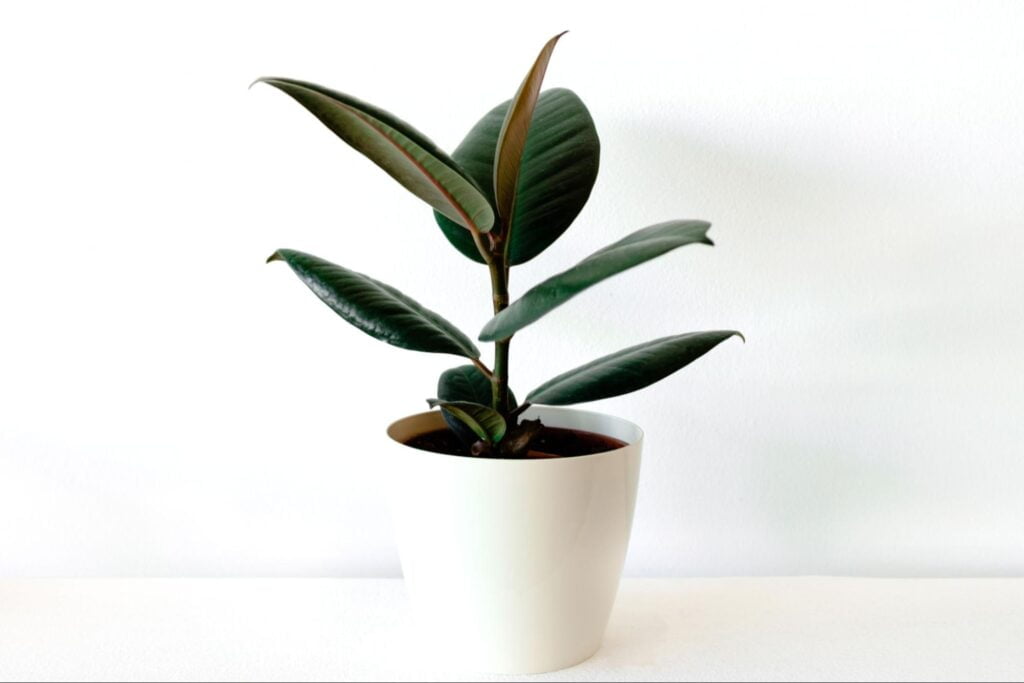
- Botanical Name Ficus elastica
- Common Name Rubber plant, rubber tree
- Plant Type Evergreen tree
- Sun Exposure Partial shade
- Native Area Asia
Have you ever seen an amazing plant that you had to touch to believe wasn’t fake? The rubber plant is one of the most beautiful indoor plants in India. It grows swiftly and has enormous, oval-shaped leaves with a brilliant green tint. Its lovely, glossy leaves in various colors – variegated green and white, burgundy, practically black – will entice you to touch them.
Care for rubber plants is very easy. It’s grown as a houseplant indoors, where it can be planted and cared for all year, and its size may be kept in check. Simply provide it with ample light, water, and warmth (it is, after all, a tropical plant), and you will have an exotic addition to your indoor plant collection. Just like when it comes to any plant, the right combination of water and light is critical. You can control the amount of light and water the rubber plant receives, which is vital because neither should be excessive.
20) Bromeliad Plant
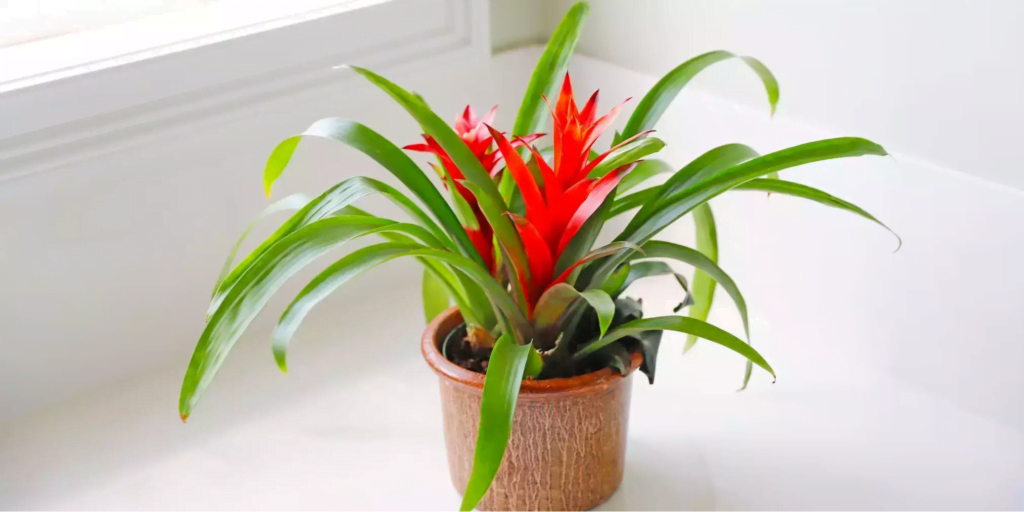
- Common Name Bromeliad
- Botanical Name Bromeliaceae genera
- Family Bromeliaceae
- Sun Exposure Bright, indirect light
- Native Area Tropical and subtropical Americas
Bromeliad plants add an exotic touch to the home and evoke thoughts of the tropics and sun-drenched settings. Bromeliads are easy to grow as houseplants and add unique texture and color to the interior landscape.
With its amazing diversity of colors and textures, the spectacular bromeliad may appear difficult to grow. Yet, it can readily adapt to typical residential settings.
Bromeliads are just as popular as attractive foliage plants, with red, green, purple, orange, and yellow leaves with bands, stripes, spots, and other features. Bromeliads are slow-growing plants that mature into floral plants in one to three years. Gardeners love this Bromeliad as it is the most beautiful indoor plant in India.
21) Kalanchoe
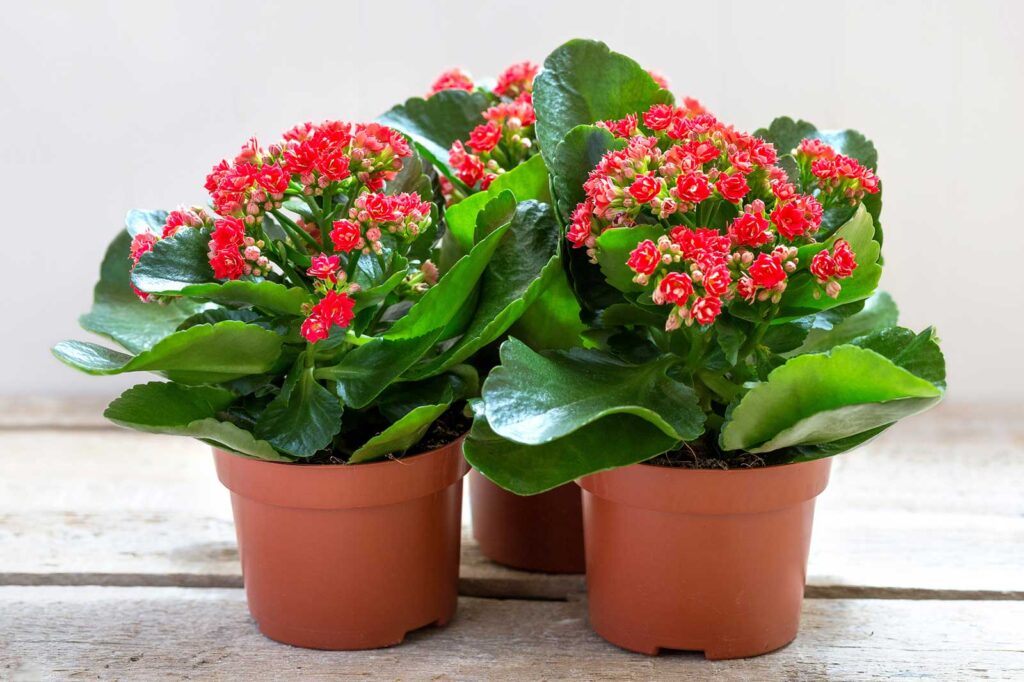
- Common Name Kalanchoe, flaming Katy, Christmas kalanchoe
- Botanical Name Kalanchoe blossfeldiana
- Family Crassulaceae
- Sun Exposure Full sun, partial shade
- Native Area Africa (Madagascar)
The Kalanchoe (Kalanchoe blossfeldiana) is one of India’s most beautiful indoor plants. It’s a long-lasting flowering potted plant that requires very little care in the home or workplace. Flaming Katy has small, four-petaled flowers in clusters held above the foliage and dark green, thick waxy leaves. The leaves have scalloped edges. A double flowering cultivar with up to 26 petals per bloom is a good pick.
Kalanchoe is popular among gardeners because of its ease of care, attractive leaves, and flowers that bloom repeatedly. This plant’s flowers come in various colors, including red, magenta, pink, orange, yellow, and white. It is a popular, easy-to-grow houseplant that thrives in arid conditions.
When compared to other succulents, Kalanchoe has a rather long bloom period. Look no further than these stunning beautiful indoor plants in India if you’re seeking a beautiful succulent to grow. Kalanchoe, like many succulents, is a low-maintenance plant that thrives in bright light and well-draining soil.
22) Ponytail Palm
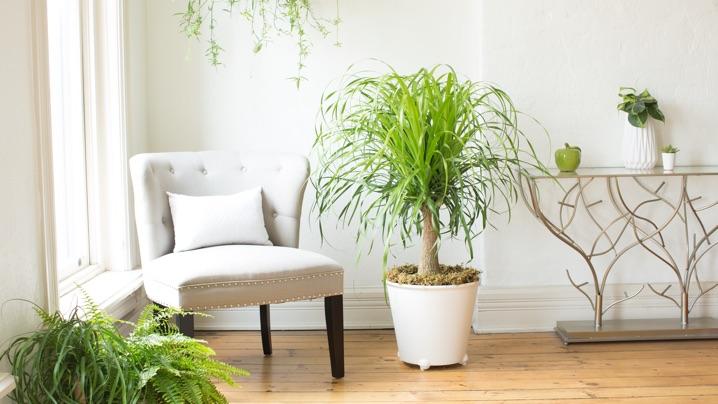
- Botanical Name Beaucarnea recurvata
- Common Name Ponytail palm, elephant’s foot
- Plant Type Broadleaf evergreen shrub/ tree
- Sun Exposure Full sun
- Native Area Semi-desert areas of Central America
If you are looking for a desk plant, ponytail palm is the one you should go for. Ponytail palms are visually gorgeous with their sleek bulb-like trunks and lush, long, curling leaves. They are forgiving and easy to care for, making them a great houseplant for many individuals. Though it is called ponytail palm, these are neither a palm nor a tree. It is, in reality, a succulent that belongs to the Agave family.
The Ponytail Palms, the most beautiful indoor plants in India, will thrive if just watered every couple of weeks and left alone to soak up the sun. This plant is ideal for people who are short on time or frequently travel. The Ponytail Palm is drought resistant, slow-growing, and low-maintenance.
23) Crown of thorns

- Botanical Name Euphorbia milii
- Common Name Christ plant, Christ thorn
- Plant Type Succulent
- Sun Exposure Full, partial
- Native Area Africa
Crown of thorns, despite its unappealing name, is a lovely succulent plant that may bloom virtually all year, even inside. The blooms are small and green, with red, orange, pink, yellow, or white bracts around them. Along with the new stem growth, thick, vivid green leaves grow.
Crowns of thorns can grow into thorny shrubs, but they are also India’s most beautiful indoor plants. It prefers the same room temperature like humans. It can cope with the low humidity levels found in most homes throughout the winter. Expect the crown of thorns to grow to about 2 feet tall as a houseplant.
Green leaves and small, bright blooms portray Crown of Thorns plants. When damaged, this plant’s spiky, prickly stems and branches exude a milky fluid. If you’re considering getting a crown of thorns as a houseplant, keep in mind that they’re highly toxic and can poison animals and humans if eaten. The dangerous white milky sap can annoy the skin and irritate the eyes.
24) ZZ plant

- Common Name Zanzibar gem, eternity plant
- Botanical Name Zamioculcas zamiifolia
- Family Araceae
- Sun Exposure Low, indirect light; semi-shade
- Native Area Eastern Africa
Want to stun people because of your indoor plant? ZZ plant is the answer. The stems of ZZ plants have an elegant, wand-like shape that begins thick and bulbous at the base and tapers to a point. The plant has fleshy, oval-shaped leaves that seem like stylized feathers along the stem. The entire plant is covered in a waxy, shiny coating that looks like it’s made of plastic. People frequently assume it is an artificial plant due to its sculptural characteristics and waxy coating.
With its wide, appealing, dark green leaves, the ZZ plants are the most beautiful indoor plants in India and are adored by all. The ZZ plant’s smooth, glossy leaves reflect light and brighten spaces. These grow slowly to a height and breadth of two to three feet, so it isn’t a terror that quickly outgrows containers. It is resistant to neglect, drought, and low light levels without irritation.
25) Schefflera
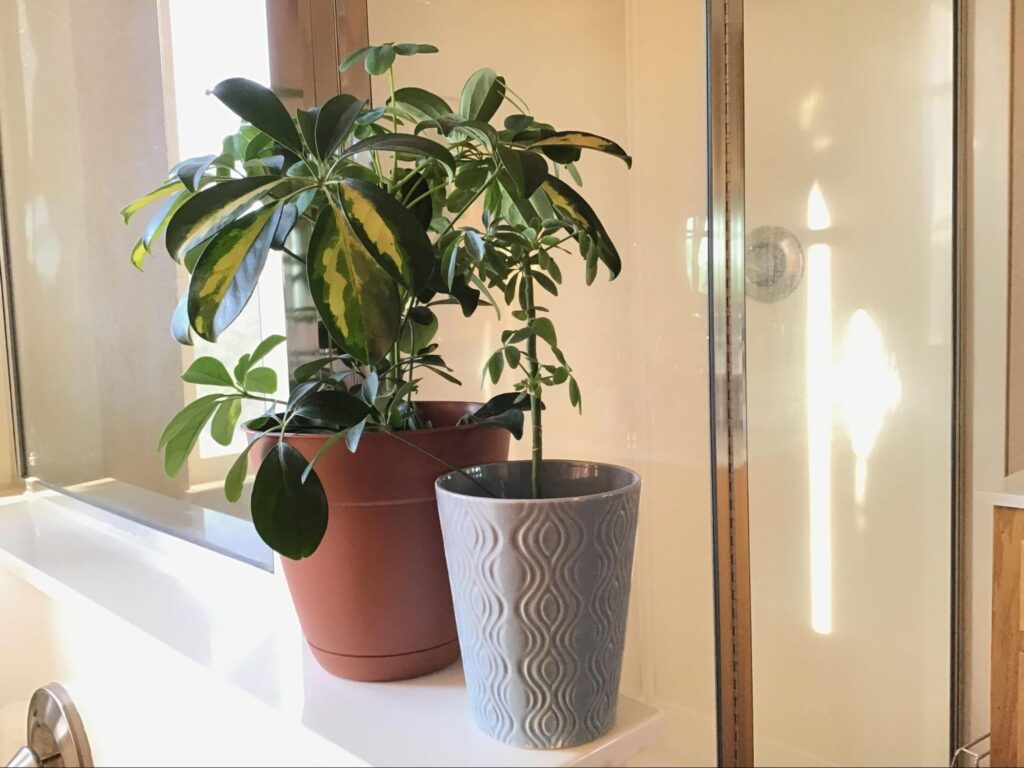
- Common Name Schefflera, umbrella plant, umbrella tree
- Botanical Name Schefflera spp.
- Family Araliaceae
- Sun Exposure Bright, indirect light
- Native Area Taiwan
It is a huge tropical plant genus with two species that make excellent tropical houseplants. The long, lustrous, oval green leaves drape gracefully from a central stem, suggesting an umbrella picture.
India’s stunning beautiful indoor plants enlighten the office and home space with their aura. Tiny, shiny leaves with creamy variegation depict Schefflera arboricola (dwarf Schefflera). A mature Schefflera can contain 12 to 16 leaflets on a single stalk, whereas an immature Schefflera can have four to six.
26) Fittonia

- Common Names Nerve plant, mosaic plant, painted net leaf
- Botanical Name Fittonia albivenis
- Family Acanthaceae
- Sun Exposure Filtered indirect sun, part shade
- Native Area South America
Fittonia (also known as the Nerve Plant, Mosaic Plant, or Net Plant) is the most adorable little drama queen you’ve ever met. What is all this about? If you don’t water your fittonia regularly, it will throw a fit. Nerve plant (Fittonia spp.) is a spreading evergreen perennial with beautifully veined, deep-green leaves typically grown as a potted houseplant.
The nerve plant is a creeper that grows slowly and is ideal for terrariums and bottle gardens. Although silvery-white veins are the most common, many gardeners can also find variations with red, pink, white, and green veins. These are the most beautiful indoor plants in India.
When growing a fittonia plant indoors, use a peaty potting mix. This stunning plant requires continual moisture and a high degree of ambient humidity, which can be achieved by misting it frequently or growing it in a tray filled with pebbles and water.
Most gardeners like you prefer to keep these attractive but fickle plants in terrariums or covered gardens, where they may enjoy the high humidity and diffuse light they crave. They’re also a great addition to bathrooms.
27) Fiddle Leaf Fig
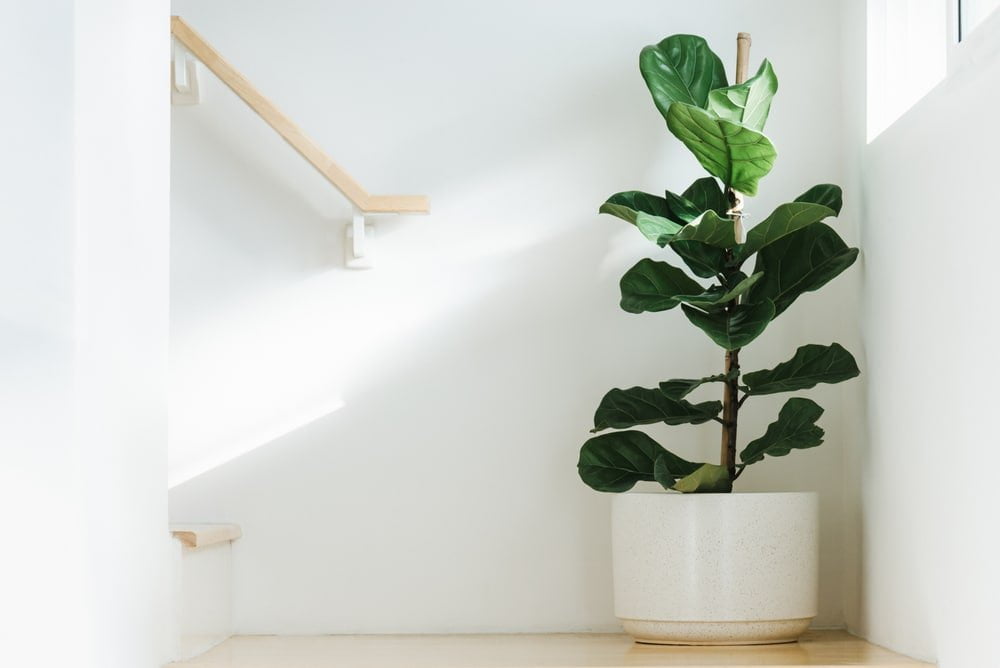
- Common Name Fiddle-leaf fig, banjo fig
- Botanical Name Ficus lyrata
- Family Moraceae
- Plant Type Broadleaf evergreen
- Sun Exposure Part shade
- Native Area Tropical western Africa
Ficus lyrata, or fiddle-leaf fig, is a popular indoor tree with enormous, deeply veined, glossy violin-shaped leaves that grow upright on a sleek stem. The majority of indoor specimens grow to be around 10 feet tall. If you can place the plant in a floor-standing container that allows it to grow to at least 6 feet tall, it makes an excellent focal point for an area.
Fiddle-leaf figs aren’t difficult to grow as long as you have the right growing conditions. This stunning beauty grows quickly and can be potted at any time of the year. Prepare to rotate your plant every few days when grown as a houseplant so that a different part faces the source of sunlight. It will grow evenly rather than leaning toward the light this way.
This fiddle leaf fig plant’s green and lustrous leaves and unusual shape make it an excellent choice for recreational places. Gardeners and non-gardeners are both amazed by these plants. These are indeed the most beautiful indoor plants in India.
28) Anthurium
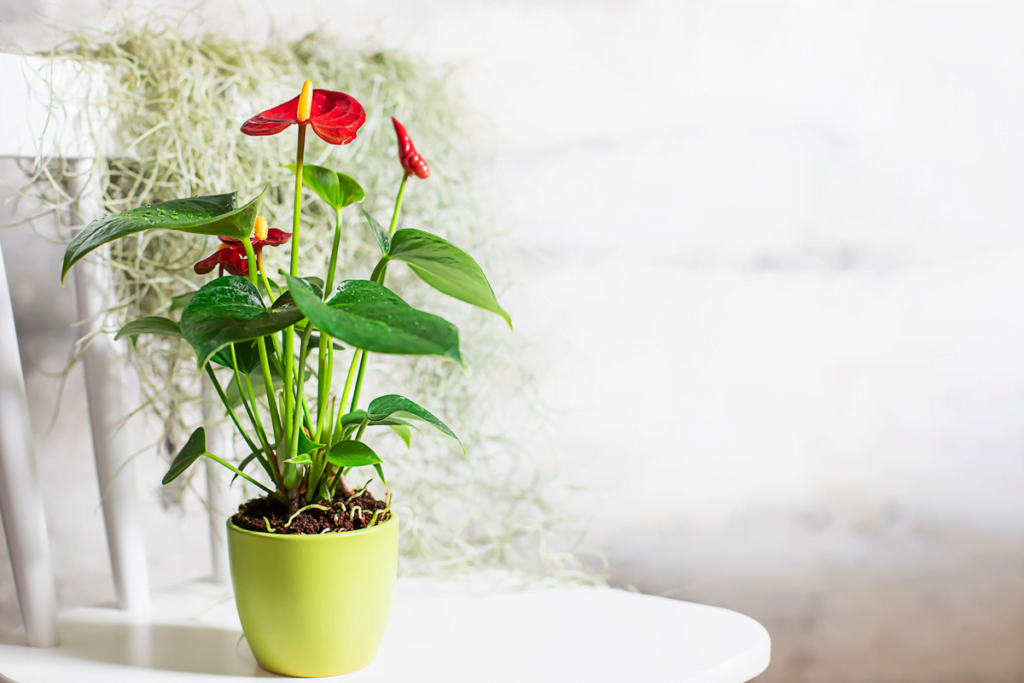
- Common Names Anthurium, tailflower, flamingo flower, laceleaf
- Botanical Name Anthurium spp.
- Family Araceae
- Sun Exposure Bright indirect light
- Native Area Central America, South America, Caribbean
Did you acknowledge that the Anthurium’s brilliant “flowers” are modified leaves? The plant’s real flowers emerge from a central structure known as an inflorescence. The Anthurium’s “flowers” are some of the longest-lasting on the planet so the vibrant color will stay for months in your house. With its open heart-shaped blossom, the plant symbolizes welcome and inspires happiness and abundance.
These beauties are also known as flamingo flowers because of their distinctive tropical shape. Anthurium can be planted all year and bloom all year. Colorful, heart-shaped waxy spathes and red or yellow tail-like flower spikes distinguish the blooming kinds. These are the most beautiful indoor plants in India. Other types have big leaves with dense veining. This plant’s vibrant red, green, and white colors make it a popular centerpiece.
29) Boston Fern

- Common Names Sword fern, ladder fern, boss fern
- Botanical Name Nephrolepis exaltata
- Family Lomariopsidaceae
- Sun Exposure Partial sun
- Native Area Americas, Africa, Polynesia
Boston fern is a traditional houseplant that’s easy to care for because it doesn’t require much light. These stunning beautiful indoor plants in India have sword-shaped, blue-green foliage with tiny leaflets that grow erect, only arching as the fronds get bigger.
Boston ferns, the most beautiful indoor plants in India, demand moist, high-nutrient soil with plenty of light. They’re stunning as a hanging plant, on a pedestal, or even on a simple side table. It’s difficult to go wrong with a fern as beautiful and hardy as this one.
The rule for caring for a Boston fern at home is never letting it dry out. Try to resist touching their fronds, even if it’s quite tempting because they don’t enjoy it, which could turn them brown.
30) Elephant Ears Plant
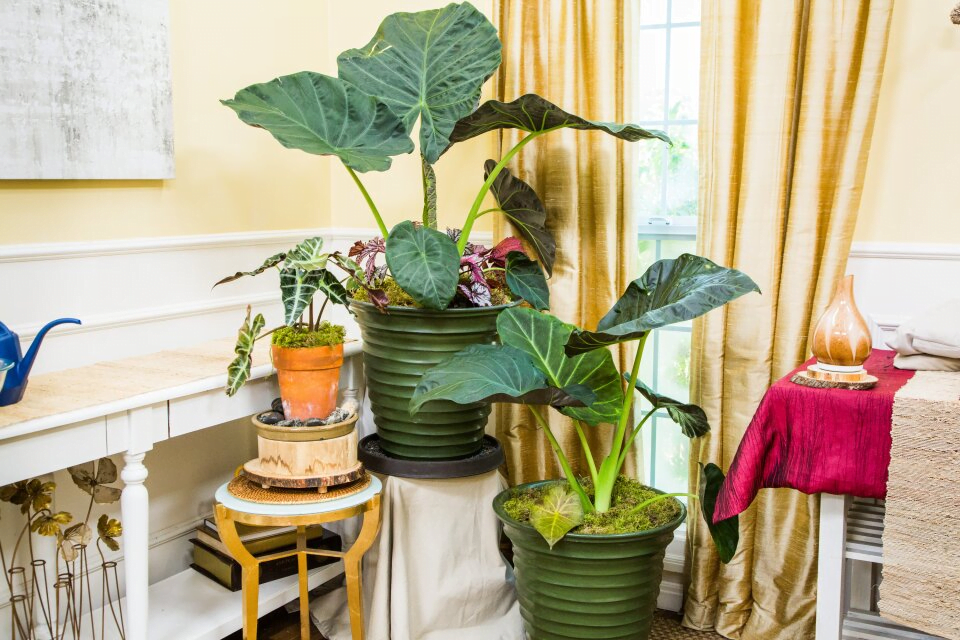
- Common Name Elephant ear, taro, cocoyam
- Botanical Name Colocasia, Alocasia, Xanthosoma spp.
- Family Araceae
- Sun Exposure Full sun to part shade
- Native Area Asia, Australia, Central, and South America, Africa
Elephant ears are indeed one of the most beautiful indoor plants in India. Practically, the elephant ear plant (Colocasia) creates a dramatic tropical impact in any landscape. Another big-leafed plant for rooms that demand a lot of natural light is Colocasia gigantean. In truth, these plants are grown for their huge, tropical-looking foliage that looks like elephant ears.
Elephant ear plants can be utilized as edging, ground coverings, or background plants, especially around ponds, walks, and patio enclosures. However, these gigantic beauties are most commonly used as an accent or focal point. These enormous beauties are a little challenging to grow indoors, but they’re well worth it. They need indirect sunshine and a lot of humidity. Many are even well-suited to container gardening.
Conclusion
Even folks who don’t have a green thumb can appreciate the beauty of indoor plants! If you were overwhelmed by the numerous choices of indoor plants, we’ve gathered information on the 30 most beautiful indoor plants in India, so there’s something for everyone. This natural touch will lift your spirits, bring green light to your home, and improve your gardening skills.
Related Articles
- Propagating Chinese Elm Bonsai Cuttings And From Seeds
- Best Chinese Elm Bonsai Soil and Fertilizer.
- Troubleshooting Common Problems With Chinese Elm Bonsai
- Buy Chinese Elm Bonsai: How Not to Get Scammed When Purchasing a Chinese Elm Bonsai Tree!
- Chinese Elm Bonsai Pruning And Styling.
- Creating a Chinese Elm Bonsai Forest- Step-By-Step Guide.

